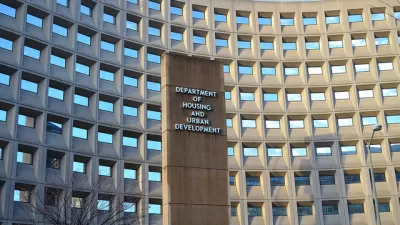Barack Obama has announced the three members of the "urban issues" arm of his incoming cabinet. Grist's Ryan Avent takes a look at Shaun Donovan, Ray LaHood and Adolfo Carrion and what they may mean for urban policy.
"A man of the city himself -- raised in Honolulu and for decades a Chicagoan -- Obama has been called the metropolitan candidate. He ran on an "Amtrak ticket" with a man who took the train to work every day, and he's even riding the rails to Washington for his inauguration. This has raised expectations among urbanists (your author included), and the president-elect has done little to discourage that enthusiasm. He paid homage to rail and transit during the campaign (in a landmark metropolitan speech, for instance) and since his election. And he has even gone so far as to create a cabinet-level Office of Urban Policy."
"But now the rubber hits the road. While Obama's commitment to better metropolitan policy is clear, he will need capable lieutenants who can hone policy details and push matters forward. His urban personnel -- his secretaries of Housing and Urban Development and Transportation, along with the head of the new Urban Policy office -- will carry the metropolitan torch for the administration. So who are they, and what do they say about an Obama urban policy?"
FULL STORY: Urban doubt-fitter

Manufactured Crisis: Losing the Nation’s Largest Source of Unsubsidized Affordable Housing
Manufactured housing communities have long been an affordable housing option for millions of people living in the U.S., but that affordability is disappearing rapidly. How did we get here?

Americans May Be Stuck — But Why?
Americans are moving a lot less than they once did, and that is a problem. While Yoni Applebaum, in his highly-publicized article Stuck, gets the reasons badly wrong, it's still important to ask: why are we moving so much less than before?

Using Old Oil and Gas Wells for Green Energy Storage
Penn State researchers have found that repurposing abandoned oil and gas wells for geothermal-assisted compressed-air energy storage can boost efficiency, reduce environmental risks, and support clean energy and job transitions.

Greening Oakland’s School Grounds
With help from community partners like the Trust for Public Land, Oakland Unified School District is turning barren, asphalt-covered schoolyards into vibrant, green spaces that support outdoor learning, play, and student well-being.

California Governor Suspends CEQA Reviews for Utilities in Fire Areas
Utility restoration efforts in areas affected by the January wildfires in Los Angeles will be exempt from environmental regulations to speed up the rebuilding of essential infrastructure.

Native American Communities Prepare to Lead on Environmental Stewardship
In the face of federal threats to public lands and conservation efforts, indigenous groups continue to model nature-centered conservation efforts.
Urban Design for Planners 1: Software Tools
This six-course series explores essential urban design concepts using open source software and equips planners with the tools they need to participate fully in the urban design process.
Planning for Universal Design
Learn the tools for implementing Universal Design in planning regulations.
Heyer Gruel & Associates PA
City of Moreno Valley
Institute for Housing and Urban Development Studies (IHS)
City of Grandview
Harvard GSD Executive Education
Salt Lake City
NYU Wagner Graduate School of Public Service
City of Cambridge, Maryland



























